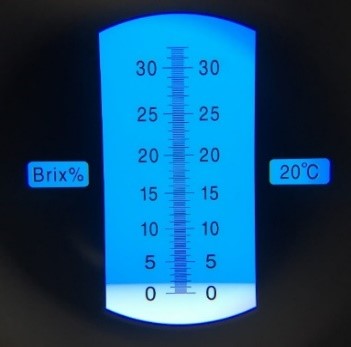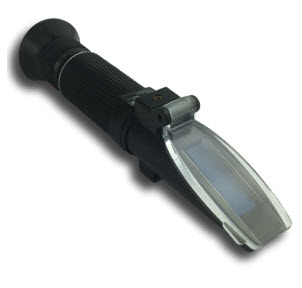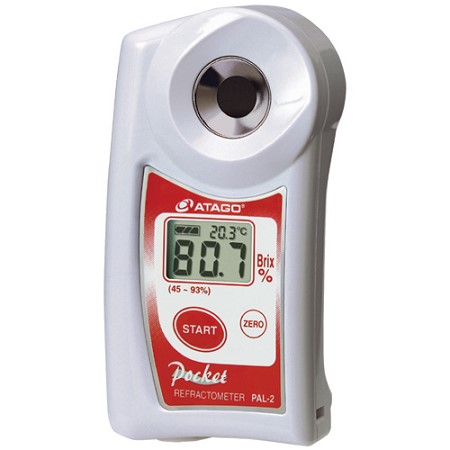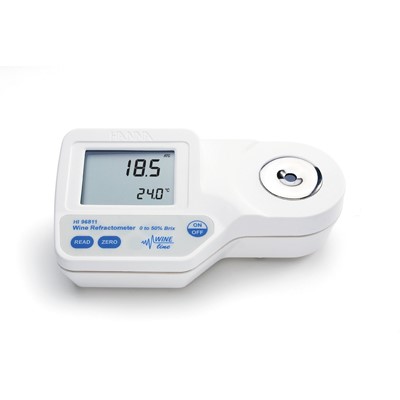What is a Brix Refractometer, and how do they work?

A Brix Refractometer is a device used across a wide range of industries and professions. One of the most common uses of these refractometers is within the food and beverage industry and, if you work this industry, you will undoubtedly be aware of the term “Brix percentage.”
About Brix Refractometers, and How They Work
When light enters a liquid at an angle, it changes direction. This phenomenon is called refraction. Light will refract more when travelling through a liquid with dissolved or suspended solids. Therefore, refraction can be used to measure the concentration of dissolved or suspended solids within a solution. Refractometers are scientific instruments that measure refraction angles and correlate them to an already established refractive index (nD).
What is the Brix Percentage?
Degrees Brix (symbol °Bx) is the sugar content of an aqueous solution. One degree Brix is 1 gram of sucrose in 100 grams of solution and represents the strength of the solution as percentage by mass. If the solution contains dissolved solids other than pure sucrose, then the °Bx only approximates the dissolved solid content.
|
Instrument Choice Scientist Tip: Refractive index readings are temperature-dependent. For accurate results, the sample and meter should be as close to 20°c as possible, that is, unless you have a device with automatic temperature compensation (ATC). ATC will automatically adjust results based on the way the refractive index of sucrose changes with temperature, ensuring accurate results. For more information, see our article. Brix Refractometers with ATC (What it is and Why it’s So Important!) . |
There is a direct relationship between the refractive index and the final Brix percentage. The Brix Scale calibrates the number of grams of pure cane sugar (sucrose) contained in 100mL of water. A refractometer uses the refractive index to convert the raw Brix scale measurement into a weight percentage of sucrose content, and this displays as % Brix.
Why Measure Sucrose as Brix Percentage?
Brix can be used to measure sucrose found within vegetables, juices, soft drinks, wine, beer, and many more plant-based foods. What’s commercially significant is there is a direct correlation between a plant’s Brix value and its taste, quality, potential alcohol content, and nutritional density.
Check out the table below for some examples of Brix percentage values for some common foods.
| Sample | % Brix |
| Oranges | 4 to 13 |
| Carbonated beverages | 5 to 15 |
| Apples | 11 to 18 |
| Grapes and wines | 14 to 19 |
| Concentrated juices | 42 to 68 |
| Jams and jellies | 60 to 70 |
Types of Brix Refractometers
There are two main designs of Brix refractometers, i.e., optical or digital devices. While both types work using the same principle, they operate slightly differently. Each type of refractometer also subdivides down into sub-groups. There are specific use Brix refractometers (e.g., for wines or jams or jellies), full Brix range refractometers, and limited Brix range refractometers.
You can check out examples of each refractometer group below.
Optical Refractometers
These simple devices require no external power to operate. You can obtain a Brix reading by adding a sample solution to the refractometer’s prism and close the lid. You then hold the device perpendicular to a light source to look through the lens and see an internal scale. The Brix reading is where the light and dark areas meet on the scale. Figure 1 depicts an optical measurement taking place.
 Figure 1: A Brix reading through optical Brix Refractometer.
Figure 1: A Brix reading through optical Brix Refractometer.
Digital Refractometers
In a similar way to optical refractometers, you take a Brix measurement using a digital refractometer by first placing the sample within a receptacle (some have covering lids, and some do not). The digital refractometer will then produce its own LED light and beam it through the sample. The device will assign the resulting refraction a numeric value based on the Brix scale and show this on an LCD screen, all within a matter of seconds.
Examples of Brix Refractometers
Our Scientists have gathered some exceptional examples from the huge variety of Brix Refractometers available at Instrument Choice.
Sugar Refractometer with ATC - IC300010 
This easy-to-use optical Brix refractometer doesn’t require a power source. Place your sample on the prism, close the lid, hold it up to your eye, and read the results. It’s that simple!
This model is extremely popular due to its broad Brix range, which makes it suitable for a variety of quality control applications.
Brix Range: 0.0-32%
Brix Accuracy: ±0.2%
ATC: Yes
Applications: Great for measuring the sugar content of whole fruit, fruit juices, wine, milk, soft drinks, and yeast culture solutions.
Waterproof Refractometer - IC-300058 .jpg?Action=thumbnail&algorithm=fill_proportional&width=206)
A full-Brix scale digital refractometer, the IC-300058 is designed to measure aqueous samples on its scratchproof sapphire lens. It can distinguish Brix percentage concentrations between 0 to 95%. In addition to the Brix scale, you can measure and display readings from the refractive index, temperature, dextran, fructose, glucose, lactose, and maltose scales.
Brix Range: 0.0 to 95%
Brix Accuracy: ±0.2%
ATC: Yes
Applications: Recommended for applications that involve sampling wine, sugar, carbonated beverages, and fruit juices. Capable of measuring samples as small as 1 ml. It is also water and dustproof with an IP67 rating, making it suitable for fieldwork.
Digital Hand-held Pocket Refractometer - IC-PAL-2 
The pocket-sized IC-PAL2 is an excellent example of a specific Brix range refractometer. It’s simple to operate and measures higher Brix concentrations.
The unit is designed with minimal assemblage parts to reduce the risk of spreading germs.
Brix Range:45.0 - 93.0%
Brix Accuracy: ±0.2%
ATC: Yes
Applications: The hygienic IC-PAL2 is popular in the food and beverage processing industries for measuring high concentration samples, such as jam, marmalade, jelly, honey and concentrated juice.
Digital – Specific Use
Refractometer For Sugar In Wine - HI96811 
The HI96811 is a specific use Brix refractometer designed for measuring wine, grape juice, and must. The device is rugged, waterproof, and yet lightweight.
The two-button ‘Zero/Calibrate’ or ‘Read’ design feature makes it easy to use. A 1.5-second sample rate is perfect if you have little time to spare.
Brix Range: 5-50%
Brix Accuracy: ±0.2%
ATC: Yes
Applications: Measuring wine, grape juice, and grape must, either in the lab or in the field.
Conclusion
Brix Refractometers are built to measure the sucrose content of a sample through refraction. There is a wide range of designs, and all are capable of incredibly quick and accurate results. These meters excel in applications within the food and beverage industries.
Browse the enormous range of Brix Refractometers available at Instrument Choice here.
Unsure of what Brix Refractometer will best suit your needs? Finding the huge range a bit daunting and need a hand? We’re here to help!
Contact us on 1300 737 871 or email [email protected]
Also interesting
The monitoring of pH is vital for many industries and levels government where quality control and safety are important considerations. Benchtop meters are a particular version of pH meter primarily used within a laboratory environment. They are one of the three main design types of pH meter.

Instrument Choice stocks proudly Horiba products as part of our mission to ensure our customers can measure anything and measure everything.
Over the past 75 years, Horiba has established an outstanding reputation for its precise measuring and analytical devices. Horiba water quality meters cover inexpensive pocket meters to professional meters designed for field or laboratory use. In this review, Instrument Choice scientists spotlight the LAQUAtwin series of eleven portable Horiba pocket meters and run through the parameters you can measure with each model.

